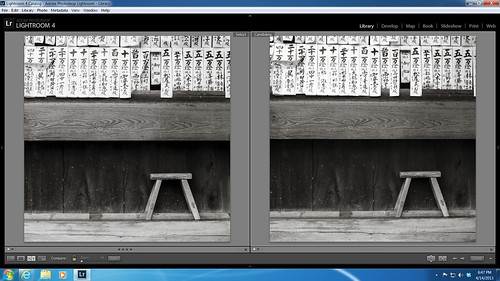Side by Side - Panasonic Lumix DMC-LX7 on Left, Zeiss Ikonta Medium Format on Right
Camera comparisons are always dangerous. So, I'll start out by saying that I did this only for my own edification. I tried to take the same picture of the scene above using two cameras - the Panasonic Lumix DMC-LX7 (which I was using as an exposure meter) and my March Skeletons From The Closet camera, the Zeiss Ikonta 521/16.
(Click Here) to read about the Ikonta.
I've written several posts about the LX7 already, so you can just search my blog for the list of posts.
What I'm trying to figure out here is what it is that I like about my old cameras. I also find myself thinking about how capable the LX7 is, and where its limitations are.
I shot both images with the respective camera mounted on a tripod. I shot the LX7 shot at iso100, versus the Portra 160 film in the Ikonta.
I uploaded the LX7 raw file to Lightroom and edited it as you see above - converted to black and white, minor cropping of the already square format image from the LX7, sharpening, and a little noise reduction.
With the Ikonta shot, I mailed the film off to The Darkroom (thedarkroom.com), waited a week (which is very fast for excellent processing service), scanned it at an outrageous high resolution, down-rezzed to a reasonable size, and edited in similar fashion to the LX7 raw image.
Then, when I was happy with each image, I compared them directly side-by-side in Lightroom (as you can see above).
What was the result? First, the LX7 image is much sharper. I was surprised by this. The prime Tessar on the Ikonta should outresolve a zoom on the LX7, right? Well, maybe it was just a focusing issue on my part; the Ikonta is a guess-focus camera. Or, it could be loss of sharpness in the scanning process.
In tonality, the images are very similar. The Ikonta image does show the wood grain a little better. I didn't notice this until seeing them next to each other. Subjectively, I can't really say that there's much difference. I would not pick one over the other. Unless I zoomed in and saw the better sharpness in the LX7 picture, I probably couldn't identify which image came from which camera at approximately 8x8" on my display screen.
Would the medium format image hold up better to big enlargements? Given that it's not as sharp to begin with, I doubt it. I don't see much noise in either image at reasonable sizes.
Again, this is not to say that the LX7 is as good as a medium format camera. Not at all. But, I find it educational that the results look so close for my normal application, which is sharing images online, and making enlargements up to 13x19" on my Epson R2400 printer.
So, I wonder why I go through all of the hurdles of using a completely manual film camera, the extra security at the airport when I ask for film to be hand-checked, waiting for film to be processed, scanning, and all the rest? Because I love it, that's why.
This exercise did two things for me. First, it reaffirmed to me that I really do photography out of love more than reason (that's what love is, right? Doing irrational things for the love of it?). Second, it made me more confident in using the LX7, even for pictures that I really care about.
How would it have done if we were comparing at iso 400? Hmm. I don't know. Maybe I'll try that next.
DMC-365.blogspot.com

I am going through a similar experiment, and like you I've gone with medium format. Another variable to consider is the film itself which will vary widely in granularity. I continue the comparison with films I have not tried before to see how close I can get.
ReplyDeleteHi Bill - sounds interesting. Where can we see the results?
ReplyDeleteReed
DMC-365.blogspot.com